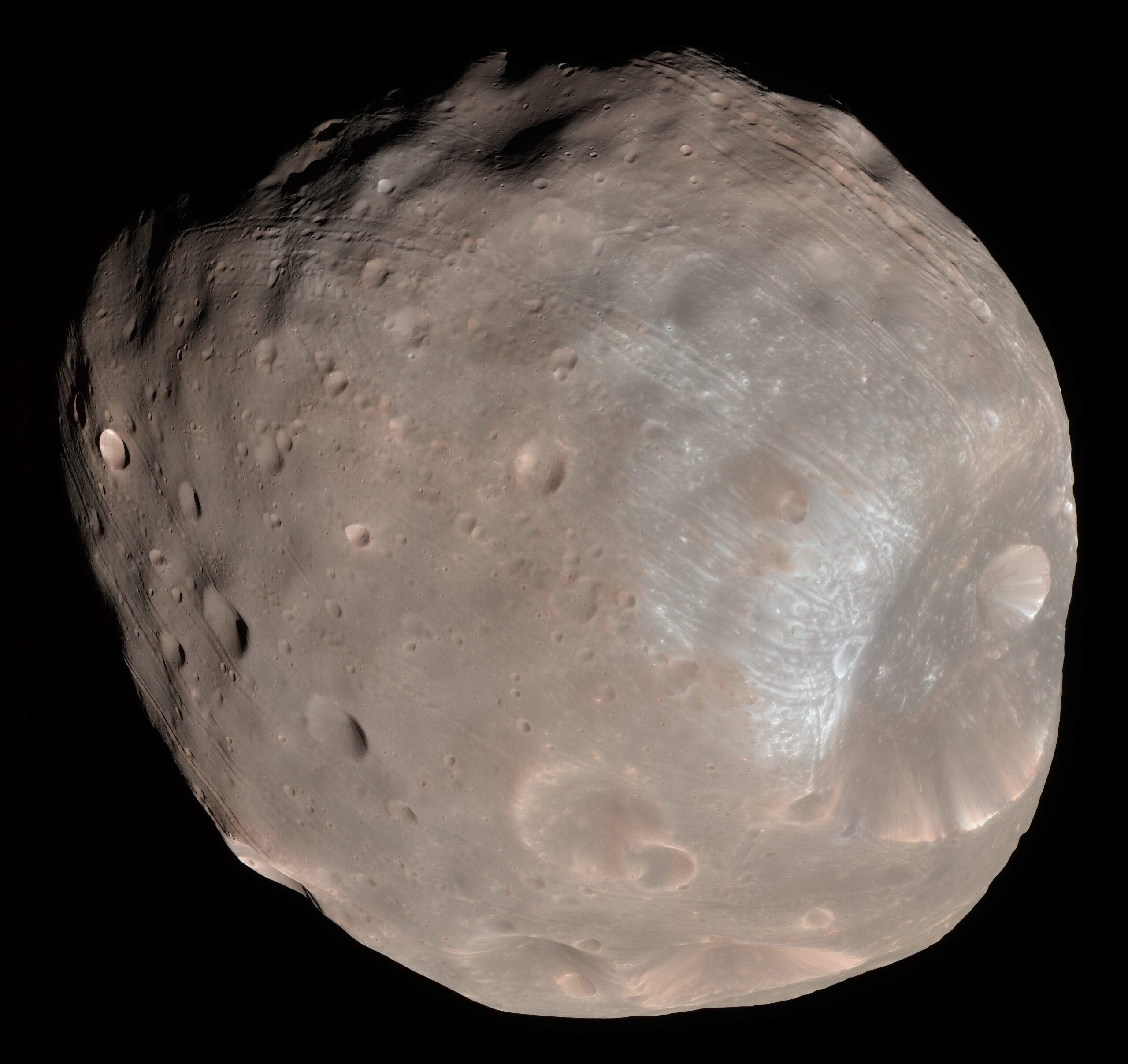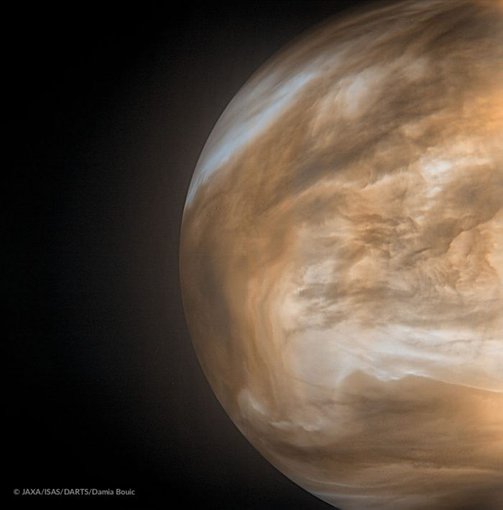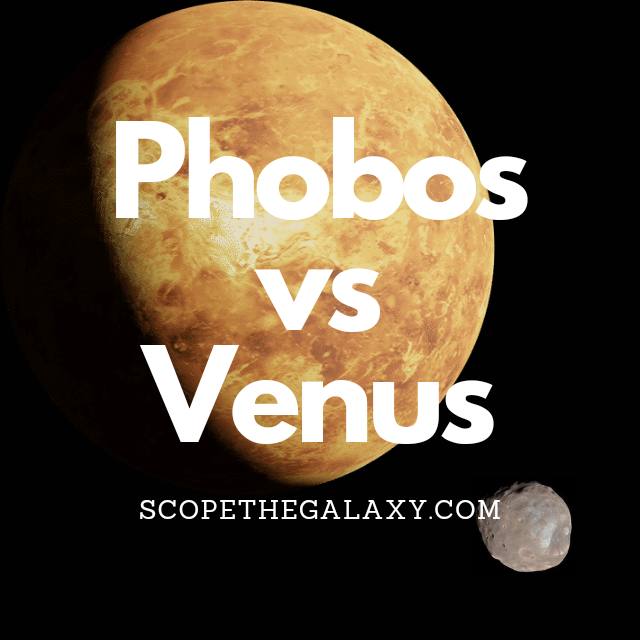*This post may contain affiliate links. This means we may make a commission if you purchase an item using one of our links*
The main differences between Phobos and Venus are that Phobos is a natural satellite while Venus is a terrestrial planet, Phobos is very small, coming in at 22.53 km while Venus is the second largest rock based planet with a diameter of 12,104km, and Venus has an atmosphere 90 times the thickness of Earth while Phobos has not atmosphere.
There are various other differences between these two entities so, continue reading if you want a more detailed look at what both these bodies are, along with their similarities and differences below.
What Is The Moon Phobos?
Table of Contents

Phobos is the larger and innermost of the Martian moons, named after the Greek God of fear and panic. This rocky satellite measures approximately 27 x 22 x 18 kilometers and possesses an irregular shape.
Flying only 270 km above Mars’s surface, Phobos orbits the Martian surface so closely that it spins around the planet three times a day (each orbit takes 7 hours and 39 minutes). And this proximity means that the moon cannot always be seen from Mars’ surface (it all depends on where you’re standing).
In general, Phobos rises in the west, passes through the sky in around 4 hours, and sets in the east. And this process occurs twice during one Martian day.
Phobos travels 1.8 m closer to Mars every 100 years, which means this doomed moon will one day crash into its planet or break up into rings. Still, this won’t happen for another 50 million years or so.
The moon is covered in streak patterns from impact craters, the most significant of which is the crater Stickney, with a diameter of 9.7 km. Phobos has weathered thousands of meteorite impacts, one of which almost shattered it to pieces.
It was first discovered by the American astronomer Asaph Hall on 17th August 1877. But, it can be difficult for astronomers to see as it is one of the least reflective bodies in the solar system with an albedo of 0.071.
Despite its small stature, Phobos experiences wildly varying temperatures on its dark side compared to the light side. Measurements on the light side of the moon suggest that temperatures can rise to -4 degrees Celsius, a sort of brisk winter’s day that would be cold but tolerable.
In contrast, temperatures on the dark side can drop to -112 degrees Celsius, even though the two areas are just a few kilometers apart. The probable cause is fine surface dust that cannot retain heat, allowing temperatures to drop rapidly.
The low density of Phobos suggests its composition is similar to carbonaceous chondrite meteorites, which could mean that Phobos is a captured asteroid.
What Is The Planet Venus?

Venus is the 2nd closest planet to the Sun and is often regarded as Earth’s sister planet. It’s very close to our Earth in size where its diameter is 12,104km. This is just over 600km less wide than our home planet.
Unlike all the planets further outside the Sun’s orbit, Venus and even Mercury have no moons orbiting it. The most probable reason for this is due to its closer proximity to it, which means that smaller objects orbit the Sun as opposed to Venus.
Venus is also the hottest planet in our solar system where its surface temperature is 475 degrees Celsius. This is due to a number of factors, like the thicker atmosphere, close proximity to Sun, the reasons for which have been explained in more detail here.
It’s core is hot too, similar to that of the ice giants and Earth, where it stands at 5,200 degrees Celsius.
As a result of this thicker atmosphere, Venus is also able to reflect a lot more of the light the Sun projects at it, making it both the hottest and brightness planet in our solar system. This is why for the longest time, and even till this day Venus is often referred to as the morning or evening star.
The thicker atmosphere is mostly compromised of carbon dioxide, and thick clouds of sulfuric acid. This does result sulfuric acid rain on the planets surface, which of course is very corrosive.
Being so close to the Sun also mean its orbital cycle is much shorter. It takes Venus 225 days to complete a full cycle, on the contrary a single day is actually longer than this where it takes around 243 days for a full rotation around its axis.
This is partially down to its distance from the Sun and the thick atmosphere surrounding this terrestrial planet. The axial tilt on Venus is also different from the other planets in our solar system where it is practically straight at 3 degrees.
All in all this is certainly one of the most interesting planets in our solar system and in many peoples eyes, could very well have supported life in the past based on how close its shape and size is to that of Earth.
Similarities Between Phobos And Venus
Phobos and Venus do have their odd few similarities, which in this case includes the below:
- Both have a rocky surface.
- Both are part of the same solar system.
- Both have no rings surrounding them.
- Neither have plate tectonics.
- Neither have other moons orbiting them.
- Neither bodies have a magnetic field.
Differences Between Phobos And Venus
As for the differences between the two, they include the below.
- Phobos orbits Mars whilst Venus only orbits the Sun.
- Venus is a spherical shape while Phobos is not.
- Venus is a terrestrial planet whilst Phobos is a terrestrial based natural satellite.
- Venus has a diameter of 12,104km whilst Phobos has a diameter of 22.53km.
- Phobos has no atmosphere whilst Venus has the thickest atmosphere amongst the terrestrial planets, where it is 90 times the thickness of Earth’s consisting of 95.32% carbon dioxide, 2.7% nitrogen, 1.6% argon and 0.13% oxygen.
- A day on Phobos takes 7 hours 39 minutes whilst a Venus day takes 243 days
- It takes Phobos 7 hours 39 minutes to orbit Mars and around the Sun in 687 days whilst Venus orbits the Sun in 225 days.
- Venus has an axial tilt of 3 degrees whilst Phobos’ axial tilt is closer to 0.
- Phobos’ temperature ranged between -4 to -112 degrees Celsius whilst Venus has an average temperature of 475 degrees Celsius, which also makes its the hottest planet in our solar system.
- Venus’ density is 5.24 g/cm³ whilst Phobo’s density is 1.88 g/cm³.
- Venus’ mass is 4.867 × 10^24 kg whilst Phobos’ mass is 10.6 × 10^15 kg.
- Phobos’ gravitational strength is 0.0057 m/s² whilst Venus’ is 8.87 m/s² .
- Phobos is tidally locked to Mars whilst Venus is not tidally locked to anything.
- Phobos only orbits Mars 6,000km away and is getting closer to the planet by 1.8 meters every 100 years.
- Venus has the most volcanoes in our entire solar system amounting to 1,600.
- Venus has a hotter central core while Phobos does not.
Summary
As a whole Venus and Phobos barely share any real commonalities besides their general rocky exterior and being a part of the same solar system.
Whether it be in regards to size, mass, atmospheric composition, gravitational strength, physical shape and more, Venus and Phobos are worlds apart and are easy to tell apart when compared to each other.

